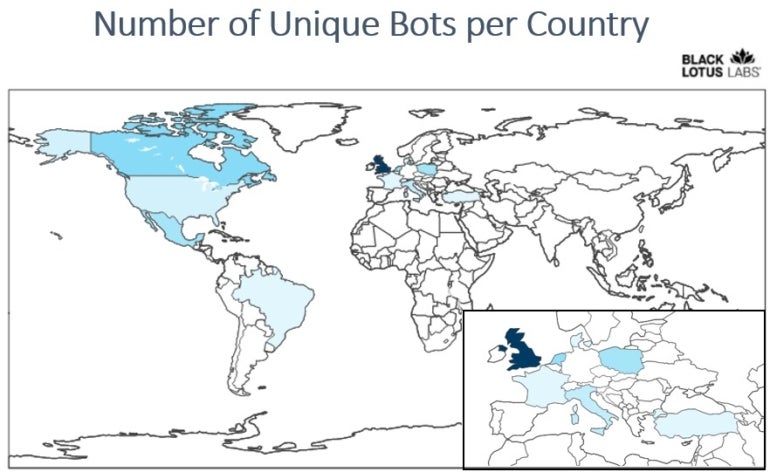[ad_1]
A new malware dubbed HiatusRAT infects routers to spy on its targets, mostly in Europe and in the U.S. Learn which router models are primarily targeted and how to protect from this security threat.

As previously exposed, routers might be used by threat actors as efficient locations to plant malware, often for cyberespionage. Routers are frequently less protected than standard devices and are often using modified versions of existing operating systems. Therefore, targeting routers can be interesting for attackers but harder to compromise and use than a usual endpoint or server.
Lumen’s Black Lotus Labs has exposed new malware targeting routers in a campaign named Hiatus by the researchers.
Jump to:
What is the Hiatus malware campaign?
The Hiatus campaign primarily targets DrayTek Vigor router models 2960 and 3900, which run an i386 architecture. These routers are mostly used by medium-size companies, as the router capabilities support a few hundred of employees’ VPN connections.
The researchers also found other malicious binaries targeting MIPS and ARM-based architectures.
The initial compromise vector stays unknown, yet once the attackers get access to the targeted routers, they drop a bash script. When that bash script is executed, it downloads two additional files: the HiatusRAT malware and a variant of the legitimate tcpdump tool, which enables network packet capture.
Once those files are run, the attackers are in control of the router and may download files or run arbitrary commands, intercept the network traffic from the infected device or use the router as a SOCKS5 proxy device, which can be used for further compromises or for targeting other companies.
HiatusRAT malware
When the RAT is launched, it checks if port 8816 is used. If the port is used by a process, it kills it and opens a new listener on the port, ensuring that only a single instance of the malware is running on the device.
It then collects information about the compromised device such as system information (such as kernel version, MAC address, architecture type and firmware version), networking information (network interfaces configuration and local IP addresses) and file system information (mount points, directory listing, file system type and virtual memory file system). In addition, it collects a list of all running processes.
After collecting all that information, the malware sends it to an attacker-controlled heartbeat C2 server.
The malware has more capabilities, such as updating its configuration file, providing the attacker with a remote shell, reading/deleting/uploading files, downloading and executing files, or enabling SOCKS5 packet forwarding or plain TCP packets forwarding.
Network packet capture
Aside from the HiatusRAT, the threat actor also deploys a variant of the legitimate tcpdump tool, which enables capturing network packets on the compromised device.
The bash script used by the threat actor showed a particular interest for connections on ports 21, 25, 110 and 143, which are usually dedicated to file transfer protocol and email transfers (SMTP, POP3 and IMAP email protocols).
The script enables more port sniffing, if necessary. If used, the packets captured are sent to an upload C2, different from the heartbeat C2, after the packet interception reaches a certain length.
This allows the threat actor to passively intercept full files transferred via the FTP protocol or emails that traverse the infected device.
Campaign targeting
Black Lotus Labs identified approximately 100 unique IP addresses communicating with the C2 servers controlled by the threat actor since July 2022, which could be classified in two categories:
- Medium-size companies running their own email servers, sometimes owning IP address ranges on the internet which are able to identify them. Companies in pharmaceuticals, IT services or consulting firms, and a municipal government, among others, could be identified. The researchers suspect that the targeting of IT firms is a choice to enable downstream access to customers’ environments.
- Internet service providers’ customer IP ranges used by targets.
The geographic repartition of the targets shows a heavy interest in U.K. companies and some other European countries, in addition to North America (Figure A).
Figure A

As reported by the researchers, approximately 2,700 DrayTek Vigor 2960 routers and 1,400 DrayTek Vigor 3900 routers are connected to the internet. The infection of only approximately 100 of those routers makes the campaign small and difficult to detect; the fact that only 100 routers out of thousands are impacted emphasizes the possibility that the threat actor is only aiming at particular targets and not interested in larger targeting.
4 steps to protect from the Hiatus malware threat
1. Regularly reboot routers and keep their firmware and software patched to prevent compromise from common vulnerabilities.
2. Deploy security solutions with capabilities to log and monitor the routers’ behavior.
3. End-of-life devices should be removed and replaced with supported models that can be updated for maximum security.
4. All traffic passing via routers should be encrypted so that even intercepting it does not make it exploitable.
Read next: Intrusion detection policy (TechRepublic Premium)
Disclosure: I work for Trend Micro, but the views expressed in this article are mine.
[ad_2]
Source link



